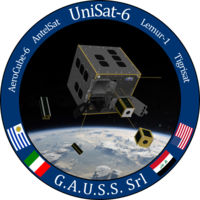cosmos.wikisort.org - Spacecraft
UniSat-6 is an Italian micro-satellite developed by GAUSS Srl and launched in 2014. The satellite is built in a 0.4x0.4x0.4m box-shaped bus, optimized for piggy-back launch. All instruments are powered by solar cells mounted on the spacecraft body, with maximal electrical power of 11W. The satellite has no on-orbit propulsion; it makes use of an attitude stabilization system based on permanent magnets.[1]
 UNISAT-6 Mission Patch | |
| Mission type | Technology demonstration |
|---|---|
| Operator | GAUSS Srl |
| COSPAR ID | 2014-033C |
| SATCAT no. | 40012 |
| Website | GAUSS Srl page on UniSat-6 mission |
| Spacecraft properties | |
| Launch mass | 26 kg (57 lb) |
| Start of mission | |
| Launch date | 19 June 2014 |
| Rocket | Dnepr |
| Launch site | Dombarovsky site 13 |
| Orbital parameters | |
| Reference system | Geocentric |
| Regime | Sun Synchronous |
| Eccentricity | 0.005957 |
| Perigee altitude | 610 km |
| Apogee altitude | 694 km |
| Inclination | 97.93 ° |
Launch
UniSat-6 was launched from Dombarovsky (air base) site 13, Russia, on 19 June 2014 by a Dnepr rocket.
Mission

The satellite is intended primarily for technology verification in space, the main test piece being 3 deployment systems loaded with 4 CubeSat satellites, namely AeroCube 6, Lemur 1, ANTELSAT and Tigrisat,[2] with a total volume 9U. All sub-satellites were deployed 25 hours after achieving orbit, without incidents.[3]
The satellite is also equipped with an on-board camera to take pictures of the release of the cubesats and for Earth Observation.
See also
- 2014 in spaceflight
References
- "UniSat 6".
- "Tigrisat CubeSat - Home". Archived from the original on 2015-09-25. Retrieved 2015-09-25.
- "UNISAT-6 CubeSat release accomplished – GAUSS SRL – Italy".
External links
На других языках
- [en] UniSat-6
[es] UniSat-6
UniSat-6 es un microsatélite italiano desarrollado por GAUSS Srl y lanzado en 2014. El satélite está construido en un bus en forma de caja de 0.4x0.4x0.4m, optimizado para el lanzamiento en piggy-back. Todos los instrumentos están alimentados por células solares montadas en el cuerpo de la nave, con una potencia eléctrica máxima de 11W. El satélite no tiene propulsión en órbita, utiliza un sistema de estabilización de actitud basado en imanes permanentes.[1]Другой контент может иметь иную лицензию. Перед использованием материалов сайта WikiSort.org внимательно изучите правила лицензирования конкретных элементов наполнения сайта.
WikiSort.org - проект по пересортировке и дополнению контента Википедии